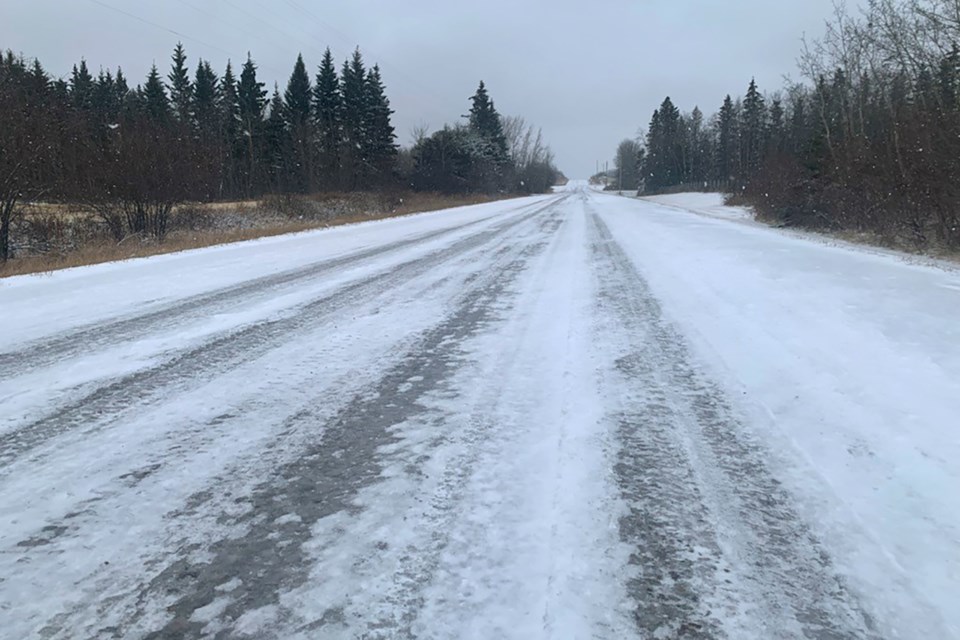LAKELAND - Last week’s snowfall officially kicked off the winter driving season. And for the next several months, motorists throughout the Lakeland region are encouraged to practice safe driving habits on shared roads.
RCMP are “reminding drivers to pay attention to their surroundings, drive slowly, and keep a safe distance from the vehicle in front of them,” according to Kellieka Formanek, St. Paul RCMP media relations officer.
As many emergency and police crews across the province are dealing with hundreds of collisions due to winter road conditions, the St. Paul area did not have the same concern last week.
“We have only had one report in the St. Paul area of a collision since the snowfall… It was not a major collision,” said Formanek.
Throughout the Lac La Biche County area, no major collisions were reported either, said Chris Clark, Lac La Biche County's manager of enforcement services. But as the season is only just beginning, drivers are reminded to adjust their speed and behaviour according to the changing weather conditions.
“Factors such as snow and black ice can create hazards that we often forget about. Drivers need to slow down before approaching intersections so they can come to a complete stop,” said Clark.
Driving alongside truckers
For motorists on the road who will be driving along rural highways, recognizing that semi-trucks have a different set of challenges in the winter is vital to keep everyone safe, according to Lorne Ringuette, B&R Eckel’s operations manager and safety director.
“A common misconception is that ‘trucks are big, heavy and they have all this traction,’ but that is not true. Big trucks, when they are loaded, yes, they have some traction; but when a big truck is not loaded, they have less pounds of pressure on the ground,” per square inch, he explained.
And for the weight comparison of semi-trucks that range from 80,000 to 120,000 lbs, compared to standard vehicles that weigh roughly 4,000 lbs, the danger is serious in the winter, Ringuette says.
“If the roads are in good condition, they [truckers] can stop pretty quickly. The braking system on trucks today is very, very good. But when it is not, these trucks will slide. Typically, until they hit something or slide off the road.”
He adds, “Cutting in front of a truck, hitting the breaks in-front of a truck… especially when the conditions are slippery… people have to realize these trucks will run right over you. It's unforgiving equipment.”
Alberta collision reports
The latest Alberta Traffic collisions statistics in 2019 found that 34 per cent of non-fatal collisions were caused by following too closely and 3.1 percent were fatal.
Throughout the province, 65.6 per cent of fatal deaths occurred on rural roads; while in urban centres, 75.9 per cent of collisions were non-fatal injuries and over three-quarters of collisions caused property damage in those areas. In total across the province, most collisions occurred in dry conditions overall. Roughly 60 per cent of collisions occurred during dry conditions compared to “slush, snow or ice” which contributed to 27 per cent of all collisions across Alberta.
Ringuette says from his experience in the trucking industry and managing safety operations, on warmer days when the snow turns into slush, truckers and vehicles have a harder time slowing down.
“People have to realize too —and a lot of them don’t—that if it's snowing and warm, it's much more dangerous and slippery than if it’s snowing and cold. Your traction if it’s snowing and it’s -5 Celsius, it’s really terrible. But if it's snowing and it’s minus -25 Celsius you have much better traction.”
As a rule of thumb, give yourself distance between other vehicles and large transportation vehicles.
“Stopping distance for a big truck is long. Take the length of the truck and times it by 10, that’s the stopping distance needed.”
As the season is just beginning, Ringuette says following safety rules and adapting to conditions is vital to not only preventing injuries or death but making sure that truckers and the goods they are carrying arrive to their destination safely, especially in rural communities where truckers are responsible for delivering almost all goods, he explained.
“In any small town, if you have any sort of products, parts and services for sale, it came by truck. Trucking is the lifeblood of this country… nothing moves without the trucks, you don't get clothes, fuel, you don’t get anything if they don’t arrive.”
Packing emergency supplies
In case of an emergency during the winter season, motorists are reminded to have all headlights, taillights and tires in working condition, and always inform someone when travelling.
“Always communicate with your family or friends and tell them your route and where you are going to. They can then call for help if you don’t arrive at your destination and emergency services can locate you more quickly. Have extra winter clothes and gloves in your vehicle so if you become stranded you are prepared for the elements,” says Clark.


